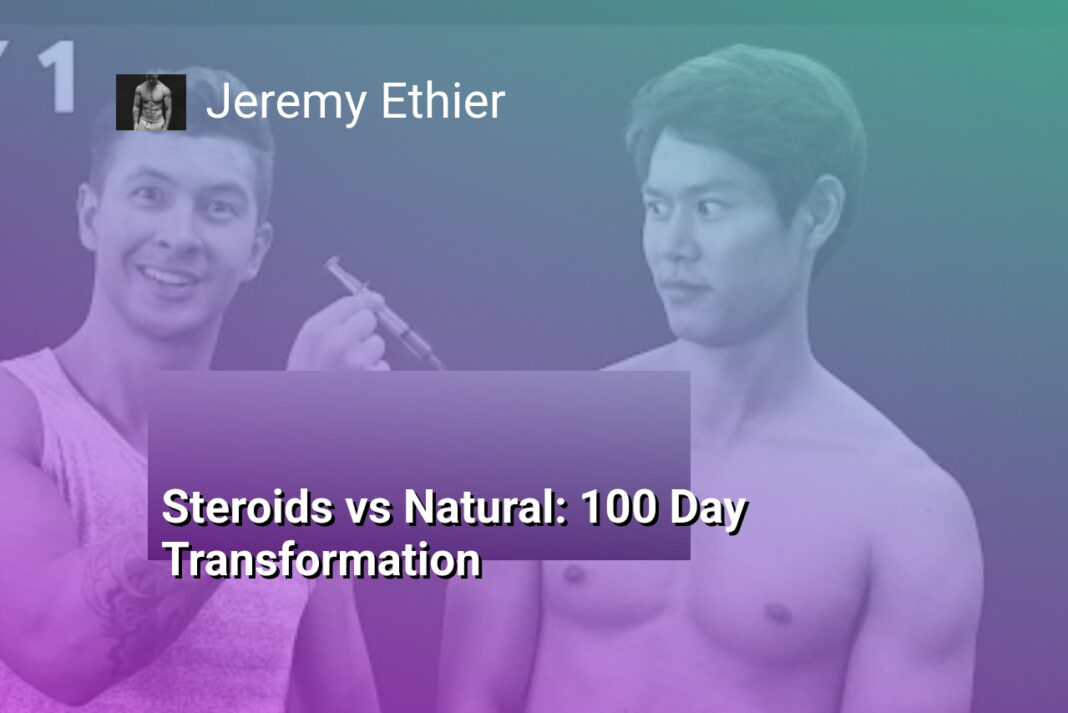The Bottom Line:
- I discovered that the experiment compared a natural lifter and a steroid user over 100 days, revealing significant differences in muscle growth and body composition strategies.
- The study highlighted how targeted exercise techniques, such as focusing on muscle stretch movements, can optimize muscle development for natural athletes.
- Nutrition played a crucial role, with strategic caloric intake and supplementation like creatine proving essential for muscle gain without performance-enhancing drugs.
- Steroid users demonstrated substantially faster muscle growth, gaining approximately three times more muscle mass compared to natural lifters during the same training period.
- Despite the performance advantages of steroids, the experiment demonstrated that dedicated natural training can still produce impressive physical transformations with the right approach and commitment.
Participant Profiles and Initial Measurements
Comprehensive Participant Background Assessment
Our experiment meticulously selected two participants with distinctly different physiological profiles and muscle-building approaches. Brandon represented the natural training trajectory, while Todd embodied the enhanced performance pathway through pharmaceutical intervention. Both participants underwent extensive initial screening to establish precise baseline measurements, ensuring scientific rigor and comprehensive data collection.
Detailed Physical Characterization
Initial assessments revealed significant disparities between participants. Brandon, at 148 pounds with 13.6% body fat, demonstrated a lean, athletic foundation typical of natural athletes. Conversely, Todd presented a more muscular starting point at 183 pounds and 19% body fat. Advanced diagnostic technologies including Dexa scans and high-resolution ultrasounds enabled precise tracking of muscle composition, body density, and potential growth trajectories.
Measurement Protocol and Diagnostic Techniques
The research methodology incorporated multiple sophisticated measurement techniques to capture nuanced physiological changes. Dexa scans provided comprehensive body composition analysis, offering insights into lean muscle mass, fat distribution, and potential skeletal variations. Ultrasound imaging allowed for granular muscle thickness measurements, enabling researchers to document microscopic muscular adaptations throughout the 100-day experimental period. These diagnostic approaches ensured that even subtle physiological transformations could be accurately documented and compared between natural and pharmaceutical-enhanced muscle development pathways.
By employing these rigorous measurement protocols, the experiment established a robust framework for comparing muscle growth mechanisms, accounting for individual genetic variations, nutritional strategies, and training intensities. The comprehensive initial assessment laid the groundwork for understanding the complex interplay between natural physiological processes and pharmacologically augmented muscle development strategies.
Strategic Training Approaches for Maximum Muscle Gain
Progressive Overload and Muscle Tension Techniques
Maximizing muscle growth requires strategic manipulation of training variables. By systematically increasing weight, repetitions, or training volume, muscles are continuously challenged beyond their current adaptation level. The key lies in creating progressive mechanical tension that stimulates muscle protein synthesis. Brandon’s approach focused on incrementally increasing load while maintaining precise movement mechanics, ensuring each repetition generated maximum muscular stress.
Exercise Selection and Biomechanical Optimization
Targeted exercise selection plays a critical role in muscle development. Compound movements like squats, deadlifts, and bench presses recruit multiple muscle groups, generating substantial hormonal responses and mechanical stress. Brandon prioritized exercises with extended time under tension and peak muscle stretch positions. For instance, Romanian deadlifts and incline dumbbell presses were strategically incorporated to maximize muscle fiber recruitment and growth potential.
Recovery and Metabolic Signaling Strategies
Muscle growth occurs during recovery, not during the actual training session. Brandon implemented sophisticated recovery protocols, including strategic nutrient timing, adequate sleep, and active recovery techniques. Consuming protein and carbohydrates within the critical post-workout window enhanced muscle protein synthesis. Additionally, implementing deload weeks every 6-8 weeks prevented training plateaus and allowed comprehensive muscular regeneration. Supplementation with creatine monohydrate further supported cellular energy production and muscle volumization, providing an additional natural performance enhancement mechanism.
Nutritional Protocols and Supplementation Impact
Strategic Nutritional Planning for Muscle Development
Nutritional protocols play a critical role in muscle growth, with precise macronutrient manipulation being essential for optimal results. Brandon’s approach focused on consuming high-quality proteins, complex carbohydrates, and strategic fat intake to support muscle protein synthesis. By maintaining a calculated caloric surplus of approximately 300-500 calories above maintenance level, he ensured consistent energy availability for muscle repair and growth.
Targeted Supplementation Strategies
Supplementation became a key component of Brandon’s muscle-building protocol. Creatine monohydrate emerged as a primary supplement, demonstrating proven effectiveness in enhancing muscle volume and strength gains. Research indicates that consistent creatine supplementation can contribute an additional 1-2 pounds of lean muscle mass during a 100-day training cycle. Beyond creatine, Brandon incorporated whey protein isolate for rapid post-workout recovery, branched-chain amino acids (BCAAs) to minimize muscle breakdown, and vitamin D3 to support hormonal optimization.
Micronutrient and Recovery Optimization
Comprehensive nutritional support extended beyond macronutrients and primary supplements. Brandon implemented a holistic approach by integrating micronutrient-dense foods and targeted supplementation to support overall physiological function. Zinc, magnesium, and vitamin B complex played crucial roles in maintaining testosterone levels, supporting metabolic processes, and enhancing recovery. Omega-3 fatty acids were strategically included to manage inflammation, support joint health, and promote optimal cellular recovery. This meticulous attention to nutritional details allowed for sustained muscle growth and minimized potential training-induced stress on the body’s systems.
Comparative Muscle Growth and Body Composition Changes
Muscle Mass Accumulation Patterns
The comparative analysis revealed significant differences in muscle growth trajectories between Brandon and Todd. Brandon’s natural muscle development followed a more gradual and consistent progression, with lean muscle gains concentrated in specific muscle groups like deltoids and biceps. In contrast, Todd’s steroid-enhanced muscle growth demonstrated a more rapid and widespread expansion across multiple muscle groups, with particularly pronounced hypertrophy in larger muscle areas such as quadriceps and chest muscles.
Body Composition Transformation Dynamics
Detailed ultrasound measurements highlighted the nuanced differences in muscle density and growth rates. Brandon’s muscle gains were characterized by a more structured and controlled increase, with minimal fluctuations in body fat percentage. His lean muscle accumulation remained around 5 pounds, maintaining a consistent 13.5% body fat throughout the experiment. Todd’s body composition transformation was dramatically different, showcasing a remarkable 13-pound muscle gain while simultaneously reducing body fat percentage from 19% to an impressively lean 7%.
Physiological Response Mechanisms
The experiment underscored the fundamental differences in physiological response between natural and enhanced muscle growth. Brandon’s muscle development relied heavily on precise training techniques, nutritional optimization, and strategic exercise selection. His approach emphasized muscle stretch-based exercises and training closer to muscular failure, which stimulated incremental muscle protein synthesis. Todd’s steroid-assisted muscle growth, by comparison, leveraged enhanced protein synthesis and accelerated recovery mechanisms, enabling more intense training sessions and substantially faster muscle accumulation. The ultrasound findings consistently demonstrated that steroid users can potentially achieve three times the muscle growth rate of natural lifters, highlighting the significant physiological advantages provided by performance-enhancing substances.
Key Insights for Natural and Enhanced Muscle Building
Strategic Muscle Development Principles
Muscle growth fundamentally depends on strategic training approaches that maximize mechanical tension, metabolic stress, and muscle damage. Natural lifters must prioritize progressive overload techniques that systematically challenge muscle fibers. This involves carefully manipulating variables like training volume, intensity, and exercise selection to continually stimulate adaptation. Focusing on compound movements that recruit multiple muscle groups simultaneously can accelerate muscle protein synthesis more effectively than isolated exercises.
Nutritional Optimization for Muscle Synthesis
Precise nutritional strategies play a critical role in muscle development, particularly for natural athletes. Protein intake must be strategically calibrated, targeting approximately 1.6-2.2 grams per kilogram of body weight to support optimal muscle protein synthesis. Carbohydrate consumption should be timed around workouts to maximize glycogen replenishment and create an anabolic environment. Micronutrient density becomes crucial, with specific attention to vitamins D, zinc, and magnesium, which directly influence testosterone production and muscle recovery mechanisms.
Recovery and Adaptation Techniques
Muscle growth occurs during recovery periods, not during actual training. Natural lifters must implement sophisticated recovery protocols that include adequate sleep, strategic deload weeks, and active recovery techniques. Implementing techniques like foam rolling, targeted stretching, and managing systemic inflammation can significantly enhance muscle repair and growth potential. Understanding individual recovery capacity and avoiding overtraining becomes paramount for sustained muscle development without pharmaceutical enhancement.





